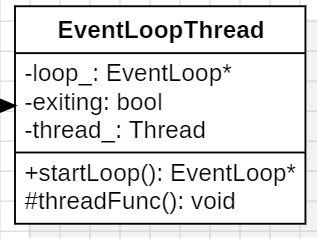前言
注:本文将重点剖析 Muduo 网络库的核心框架,深入探讨作者精妙的代码设计思路,并针对核心代码部分进行重写,将原本依赖 boost 的实现替换为原生的 C++11 语法。需要说明的是,本文并不打算对整个 Muduo 库进行完整的重写。Muduo库源码链接
在前面几篇博客中,我们已经对 基础模块 和 事件循环模块 进行了初步讲解,特别是在事件循环模块中重点介绍了 Channel、Poller 以及 EventLoop 的作用,分析了它们之间的联系以及协同工作的方式。
在此基础上,我们可以进一步思考一个问题:如何保证 EventLoop 在一个线程中独立运行,即如何确保线程对 EventLoop 生命周期的控制? 用户在使用 Muduo 库时,可以通过 setThreadNum 方法来设置 SubLoop(工作线程) 的数量,从而创建多个 EventLoop。这就引出了一个关键点:如何实现并严格保证 One Loop Per Thread 的设计原则?
答案是:我们将 线程 抽象为
Thread类,并进一步结合EventLoop和Thread,设计出EventLoopThread类。在此基础上,为了实现多个工作线程的管理,引入了线程池的概念,将多个EventLoopThread抽象为EventLoopThreadPool。通过EventLoopThreadPool,用户只需设置线程数量,即可创建多个事件循环,同时严格遵循了One Loop Per Thread的设计原则。
本篇将介绍Muduo网络库的线程有关模块,具体如下:
ThreadEventThreadEventThreadPool
Thread
CurrentThread
在上篇博客中提到:在EventLoop类中有一个成员变量(threadId_ :const pid_t),其用来标识此EventLoop的线程号。在构造函数中,对其初始化如下:
cpp
threadId_(CurrentThread::tid())CurrentThread::tid(), 现在我们来拨开它神秘的面纱。其定义如下(不是源版,而是精简重写版):
cpp
/*
CurrentThread.h
*/
namespace CurrentThread
{
/*
每个线程都有一个唯一的ID
*/
extern thread_local int t_cachedTid;
void cacheTid();
inline int tid()
{
if(__builtin_expect(t_cachedTid == 0, 0)){
cacheTid();
}
return t_cachedTid;
}
}
/*
CurrentThread.cc
*/
namespace CurrentThread
{
thread_local int t_cachedTid = 0;
void cacheTid()
{
if(t_cachedTid == 0)
{
t_cachedTid = static_cast<pid_t>(::syscall(SYS_gettid));
}
}
}解析:
-
t_cachedTid:这是一个整型类型,并用
thread_local修饰。这意味着每个线程都有一个单独的t_cachedTid,其含义表示为每个线程的tid为CurrentThread::t_cachedTid。每个线程都可以通过CurrentThread::tid()返回它们自己的线程号(因为tid()返回t_cachedTid)。 -
cacheTid:此函数的作用为获取本线程的线程号并将其缓存起来。获取TID所用的系统调用为
syscall(SYS_gettid),而pthread_self()获取的也是线程ID。它们两个有什么区别呢?syscall(SYS_gettid)返回的是当前线程的内核线程 ID(Thread ID,简称TID)。
pthread_self获取的是线程库(POSIX Thread Library)中的线程 ID,简称为pthread_t。
TID是由 Linux 内核分配的,线程在内核中的唯一标识,系统中只有一个TID。pthread_t是由用户态的线程库管理的,并不是内核线程的唯一标识。 -
tid():其作用为返回当前的线程TID。其中用到了
__builtin_expect(t_cachedTid == 0, 0),表示t_cachedTid == 0这个表达式为假的概率更高。__builtin_expect是 GCC 提供的一种编译器内置函数,用于优化分支预测 。它的作用是让程序员显式地告诉编译器某个条件的可能性 ,从而帮助编译器生成更高效的代码。第一个参数为一个条件表达式,第二个参数表示为 表达式哪个(真/假)概率较高。
Thread代码
Thread 类的作用 可以概括为:在一个线程中运行指定的函数,同时提供控制该线程(启动、停止等)的接口 。Muduo作者对线程进行了封装,在这里我们进行简化利用C++11中的thread库表示。

cpp
class Thread : noncopyable
{
public:
using ThreadFunc = std::function<void()>;
explicit Thread(ThreadFunc, const std::string& name = std::string());
~Thread();
void start();
void join();
bool started() const { return started_; }
pid_t tid() const { return tid_; }
const std::string& name() const { return name_; }
static int numCreated() { return numCreated_; }
private:
void setDefaultName();
private:
static std::atomic_int numCreated_; // 已创建线程的数量
bool started_; // 是否开始运行函数
bool joined_; // 是否join
std::shared_ptr<std::thread> thread_; // 线程
pid_t tid_; // TID
ThreadFunc func_; // 要运行的函数
std::string name_; // 线程的名字
};Thread.cc
cpp
std::atomic_int Thread::numCreated_(0);
Thread::Thread(ThreadFunc func, std::string const &name) :
started_(false),
joined_(false),
tid_(0),
func_(std::move(func)),
name_(name)
{
setDefaultName();
}
Thread::~Thread()
{
if(started_ && !joined_)
{
thread_->detach();
}
}
void Thread::start()
{
started_ = true;
sem_t sem;
sem_init(&sem, false, 0);
// 创建一个线程,执行EventLoopThread::threadFunc
// 为了获取新线程的线程号,通过信号量机制同步线程
thread_ = std::shared_ptr<std::thread>(new std::thread([&](){
tid_ = CurrentThread::tid();
sem_post(&sem);
func_();
}));
sem_wait(&sem);
}
void Thread::join()
{
joined_ = true;
thread_->join();
}
void Thread::setDefaultName()
{
int num = ++numCreated_;
if(!name_.empty())
{
char buf[32];
snprintf(buf, sizeof buf, "Thread%d", num);
name_ = buf;
}
}解析:
start() 方法用于启动一个独立的线程运行 func_,并缓存新创建线程的 TID。为了在 start() 方法运行完成后能够立即获取新创建线程的 TID,需要处理线程间的同步问题。本代码采用了信号量机制(沿用原作者的做法),确保 start() 方法返回时,线程的 TID 已经正确设置,从而可以立即获取该 TID。
EventLoopThread
该类封装了 EventLoop 和 Thread,并将事件循环处理函数作为 Thread 的构造参数,从而确保了 One Loop Per Thread 的设计原则。同时,该类还提供了创建线程并启动事件循环的便捷接口,方便用户高效地管理线程和事件循环的结合。

EventLoopThread.h
cpp
class EventLoopThread : noncopyable
{
public:
using ThreadInitCallback = std::function<void(EventLoop*)>;
explicit EventLoopThread(const ThreadInitCallback& cb,
const std::string& name = std::string());
~EventLoopThread();
// 提供给外部开启事件循环的线程
EventLoop* startLoop();
private:
// 向Thread传递的函数对象
void threadFunc();
private:
EventLoop* loop_;
bool exiting_;
Thread thread_;
std::mutex mutex_;
std::condition_variable cond_;
ThreadInitCallback Callback_;
};解析:
成员变量
loop_:管理的线程Thread内的SubLoopexiting_:是否正在退出thread_:管理的线程cond_:条件变量,确保thread_内的EventLoop的地址能够被EventLoopThread获取
EventLoopThread.cc
cpp
EventLoopThread::EventLoopThread(ThreadInitCallback const &cb,
std::string const &name) :
loop_(nullptr),
exiting_(false),
thread_(std::bind(&EventLoopThread::threadFunc, this), name),
mutex_(),
cond_(),
Callback_(cb)
{}
EventLoopThread::~EventLoopThread()
{
exiting_ = true;
if(loop_ != nullptr)
{
loop_->quit();
thread_.join();
}
}
/*
此函数作用:
1. 创建一个新线程
2. 在新线程中定义一个局部变量EventLoop(栈上)
3. EventLoop开启循环
4. 返回EventLoop地址
*/
EventLoop *EventLoopThread::startLoop()
{
// 在EventLoopThread::EventLoopThread中为成员变量thread_绑定了函数对象EventLoopThread::threadFunc,但未创建新线程。
// 在start中,创建了一个新的线程,并得到新线程的线程号
thread_.start();
EventLoop* loop = nullptr;
{
std::unique_lock<std::mutex> lock(mutex_);
while( loop_ == nullptr)
{
cond_.wait(lock);
}
loop = loop_;
}
return loop;
}
// Thread::start()中使用此函数创建了新的线程,此线程就是subloop
// 在startLoop中,利用条件变量等待此函数创建好EventLoop
void EventLoopThread::threadFunc()
{
EventLoop loop;
if(Callback_)
{
Callback_(&loop);
}
{
std::unique_lock<std::mutex> lock(mutex_);
loop_ = &loop;
cond_.notify_one();
}
loop.loop();
std::unique_lock<std::mutex> lock(mutex_);
loop_ = nullptr;
}EventLoopThreadPool
EventLoopThreadPool 是一个线程池,封装了多个 EventLoopThread,并支持动态设置线程池的大小。当 MainLoop 接收到客户端连接后,EventLoopThreadPool 会根据负载均衡算法选择一个 SubLoop,由其负责该连接后续的所有事件处理。

EventLoopThreadPool.h
cpp
class EventLoopThreadPool : noncopyable
{
public:
using ThreadInitCallback = std::function<void(EventLoop*)>;
EventLoopThreadPool(EventLoop* baseloop, const std::string& name);
~EventLoopThreadPool();
void setThreadNum(int numThreads) { numThreads_ = numThreads; }
void start(const ThreadInitCallback& cb = ThreadInitCallback());
// 如果工作在多线程,baseLoop_默认以轮询方式分配channel给subloop
EventLoop* getNextLoop();
std::vector<EventLoop*> getAllLoops();
bool started() const { return started_; }
private:
EventLoop* baseloop_; // mainloop
std::string name_;
bool started_;
int numThreads_;
int next_;
std::vector<std::unique_ptr<EventLoopThread>> threads_;
std::vector<EventLoop*> loops_;
};解析:
成员变量:
baseloop_:MainLoopthreads_:存储了numThreads个的EventLoopThreadloops_:存储了numThreads个的loops_
成员方法:
setThreadNum():设置线程的数量start():创建多个线程,并在线程内启动事件循环getNextLoop:轮询算法获取EventLoop,成员变量next_表示下一个该取得EventLoop
EventLoopThreadPool.cc
cpp
EventLoopThreadPool::EventLoopThreadPool(EventLoop *baseloop, std::string const &name) :
baseloop_(baseloop),
name_(name),
started_(false),
numThreads_(0),
next_(0)
{}
EventLoopThreadPool::~EventLoopThreadPool() {}
void EventLoopThreadPool::start(ThreadInitCallback const &cb)
{
started_ = true;
for(int i = 0; i < numThreads_; i++)
{
char buf[name_.size() + 32];
snprintf(buf, sizeof buf, "%s%d", name_.c_str(), i);
EventLoopThread* t = new EventLoopThread(cb, buf);
threads_.push_back(std::unique_ptr<EventLoopThread>(t));
loops_.push_back(t->startLoop());
}
if(numThreads_ == 0 && cb)
{
cb(baseloop_);
}
}
EventLoop *EventLoopThreadPool::getNextLoop()
{
EventLoop* loop = baseloop_;
if(!loops_.empty())
{
loop = loops_[next_++];
if(next_ >= loops_.size()) next_ = 0;
}
return loop;
}
std::vector<EventLoop *> EventLoopThreadPool::getAllLoops()
{
if(!loops_.empty())
{
return std::vector<EventLoop*>(loops_);
}
else
{
return loops_;
}
}解析:
void start(ThreadInitCallback const &cb):方法的作用是创建多个线程,并在每个线程中启动事件循环,同时将线程及其对应的事件循环实例存储起来。